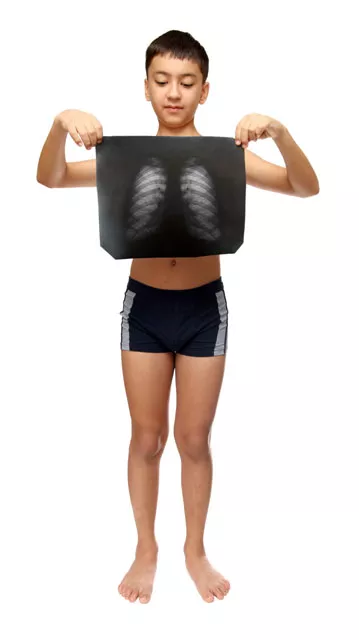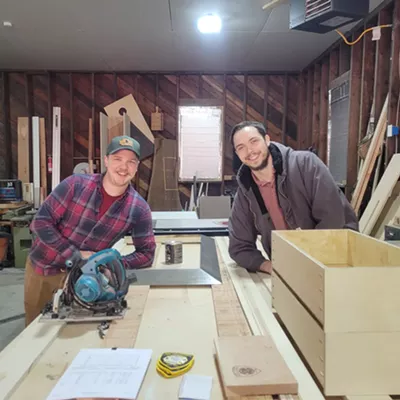It’s the kind of sleepy panic that grips you in the middle of the night: Your child has radiation poisoning. First, you let them fall down the stairs, get injured in flag football or ignored a cavity. Then you chose to allay your fears by getting X-rays or a Computerized Tomography scan.
Even that decision can bring up different worries. Will he get cancer? Will I ever have grandchildren?
“We had to get our son John [at the time, aged 2] X-rayed because he twisted his foot going down a slide at Comstock,” explains Elizabeth Shultheis. “We almost didn’t, due to the radiation fear.”
She says she was concerned it would affect her toddler’s ability to have children later.
“We weighed the factors: Radiation, or a broken or sprained ankle that could possibly heal wrong and impair his walking and running for life?” she says. “We got the X-ray, but there’s always that fear.”
Here’s a quick fact to help you get back to sleep: The amount of exposure from a foot X-ray is so small it’s almost immeasurable — just 0.5 millirems, the standard unit of measurement for medical radiation. It’s about the same as a bitewing dental X-ray.
Also, medical imaging specifically targets one body area, so a scan of the foot doesn’t affect any other part of the body (including any reproductive parts).
The average person is exposed to 360 mrems of “background radiation” each year just from living in a brick house, driving a car or cooking with a camp stove. The Washington State Department of Health sets the yearly radiation dose limit at 5,000 mrems. So, it would take 10,000 foot X-rays or dental X-rays (these numbers are based on adults; the levels for acceptable child doses are smaller) to be considered, from both a legal and medical standpoint, unsafe.
While a foot X-ray in an otherwise healthy child may be a non-issue, repeated CT scans are a different story.
Here’s why. An X-ray beam passes once, back to front, through the skin and underlying soft tissues of a targeted area. The CT scan uses multiple X-ray beams projected at many angles to create three-dimensional cross-sections of the area. While a scan of the head produces about 200 mrems of exposure, getting that cross-sectional look at a dense abdomen, pelvis, spine or heart is more significant. For these areas, a CT uses 1,000 to 3,000 mrems. If a severe injury or disease calls for repeat scans, you can see how the “safe” limit of radiation can be quickly surpassed.
More than 7 million children undergo CT scans each year, a number that has been steadily increasing since 1980. That’s why the Alliance for Radiation Safety in Pediatric Imaging has created “Image Gently,” a campaign devoted to increasing awareness of the opportunities to lower radiation exposure when treating children,.
While their website notes the increased cancer risk from one CT scan is probably negligible, it also warns the risk is cumulative. “Each subsequent CT scan will increase the risk accordingly,” the site states. Though the risk is low for individuals, the population at large is in greater danger owing to the number of CT scans performed.
Endorsed by both the American College of Radiation and the American Academy of Pediatrics, Image Gently works with hospitals and imaging centers to reduce both the number of referrals and the radiation dosages related to diagnostic imaging of children. It also provides information for parents about types of tests, relative risks and possible alternatives.
“We follow ALARA — As Low As Reasonably Achievable —guidelines” for pediatric imaging, explains Dr. Terri Lewis, a radiologist at Inland Imaging who specializes in pediatrics. “All new scanners have dose modulation,” which adjusts the amount of radiation to a patient’s weight and density.
“Each type of body has a different protocol … everything depends on the patient,” she says.
Magnetic Resonance Imaging, for instance, works without radiation, instead using magnetic waves to create images. But MRIs are often inappropriate for children because patients need to lie still, and often require sedation (another potential risk).
For children with conditions like appendicitis, the first step is usually an ultrasound. While abdominal CTs have been commonly ordered in the past, Inland Imaging has changed that protocol, both in its centers and ERs. “Ultrasound can’t see through bone, but in children the structures are closer to the skin,” says Lewis.
Ultrasounds thus provide a picture sufficient to form a diagnosis. But for monitoring cancer, chronic diseases and in certain traumatic situations like automobile accidents, when not monitoring can risk death, CT scans are used.
“We use the lowest possible dose for a study that is still of diagnostic value,” she says. “It’s yet another delicate risk balance that is the art of medicine.”
Lewis says she works with hundreds of referring physicians in the Spokane area, and those who work with young patients are her most conscientious partners. They usually do their best to limit the children’s exposure to radiation.
Still, if a parent fees uncomfortable about a scan, Dr. Lewis says it’s all right to second-guess a doctor’s order. “I would very strongly recommend that they discuss imaging tests if they have concerns, and the pediatrician is their frontline source of information,” she says.
Lewis admits some parents may feel awkward challenging a doctor.
“You’re questioning their authority. The request may be received with different levels of trust or offense,” but she says, “Parents need to be an advocate for their child.”
For more information, www.imagegently.org where you can download My Child’s Medical Imaging Record, which is similar to an immunization record, to track the date, type of exam and where the study was performed.















